
El Reno is a city in and county seat of Canadian County, Oklahoma, United States. As of the 2020 census, the city population was 16,989, marking a change of 1.55% from 16,729, recorded in the 2010 census. The city was begun shortly after the 1889 land rush and named for the nearby Fort Reno. It is located in Central Oklahoma, about 25 miles (40 km) west of downtown Oklahoma City.
Boggy Depot is a ghost town and Oklahoma State Park that was formerly a significant city in the Indian Territory. It grew as a vibrant and thriving town in present-day Atoka County, Oklahoma, United States, and became a major trading center on the Texas Road and the Butterfield Overland Mail route between Missouri and San Francisco. After the Civil War, when the MKT Railroad came through the area, it bypassed Boggy Depot and the town began a steady decline. It was soon replaced by Atoka as the chief city in the area. By the early 20th century, all that remained of the community was a sort of ghost town.

Fort Supply was a United States Army post established on November 18, 1868, in Indian Territory to protect the Southern Plains. It was located just east of present-day Fort Supply, Oklahoma, in what was then the Cherokee Outlet.

The historic U.S. Route 66, sometimes known as the Will Rogers Highway after Oklahoma native Will Rogers, ran from west to northeast across the state of Oklahoma, along the path now taken by Interstate 40 (I-40) and State Highway 66 (SH-66). It passed through Oklahoma City, Tulsa, and many smaller communities. West of the Oklahoma City area, it has been largely replaced by I-40; the few independent portions that are still state-maintained are now I-40 Business. However, from Oklahoma City northeast to Kansas, the bypassing I-44 is mostly a toll road, and SH-66 remains as a free alternate.

Oklahoma City Union Depot is a building in Oklahoma City, Oklahoma that served as a "union station" from 1931 until 1967. It was listed on the National Register of Historic Places in 1979. It now houses the offices of the Scissortail Park Foundation.
Colbert's Ferry was an important Red River crossing between Texas and Indian Territory from about 1853 to 1899. Both the Texas Road and the Butterfield Overland Mail route crossed here. It was located on the Texas Road about 3 miles (4.8 km) southeast of present–day Colbert, Bryan County, Oklahoma. The nearest town on the Texas side of the river is Denison.
The Oklahoma, Kansas and Texas Railroad (OKT) was a railroad operating in its namesake states in the 1980s.

Fort Reno is a former United States Army cavalry post west of El Reno, Oklahoma. It is named for General Jesse L. Reno, who died at the Battle of South Mountain in the American Civil War.
The St. Louis, El Reno and Western Railway was a small struggling railroad, started by local business interests in the Territorial Capital of Guthrie, Oklahoma. The railroad was built to move freight and passengers from eastern connections at Guthrie, West to the huge Rock Island Railroad hub and system cross roads at El Reno, Oklahoma. Working through the oil boom of the early-20th century with service to the South end of the large "Cashion Pool" and the boom towns of Piedmont, Richland and Navina.

El Reno High School is a set of school buildings in El Reno, Oklahoma.
The Choctaw, Oklahoma and Gulf Railroad (CO&G), known informally as the "Choctaw Route," was an American railroad in the states of Arkansas and Oklahoma.
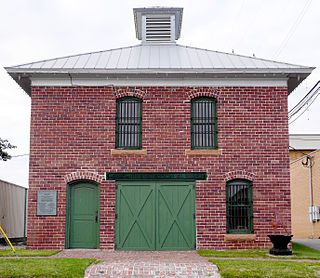
The Canadian County Jail and Stable comprises two buildings constructed at different times. The jail is a building located at 300 South Evans in El Reno, Oklahoma. It is the abandoned site of the county jail of Canadian County, and sits west of the current county jail on the same block.

Avant's Cities Service Station is a historic service station located at 220 S. Choctaw in El Reno, Oklahoma. The Art Deco building was constructed in 1933 as a service station for Cities Service Company to fuel automobiles traveling on U.S. Route 66. The station was added to the National Register of Historic Places in 2004.
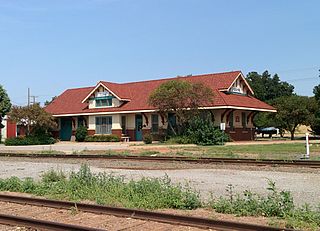
The Sayre Rock Island Depot is a historic railroad station located at 106 E. Poplar Ave. in Sayre, Oklahoma. The depot was built in 1927 along the Chicago, Rock Island and Pacific Railroad ; it replaced Sayre's original Rock Island station, which opened outside the town limits in 1901. The new station is just two blocks north of downtown Sayre. It accommodated the increased traffic the line had gained in the early 1920s; it also helped the railroad compete with the recently designated U.S. Route 66. The station building was built from and has an Italian Renaissance Revival design. Its design resembles two other surviving Rock Island stations in Oklahoma: the Hobart Depot and the Walters Depot.
The Merchants National Bank Building is a two-story, red brick building in Lehigh, Oklahoma, located at the southwest corner of Main Street and Railway Street. It was one of two banks that served Lehigh during the town's mining boom. It is listed on the National Register of Historic Places. It is historically significant because it represents the economic growth and decline of Lehigh and exemplifies Late Victorian Renaissance architecture.
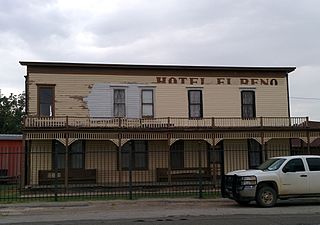
The El Reno Hotel is a two-story, wood-frame, Folk Victorian structure in El Reno, Oklahoma. It is the oldest surviving commercial building in the city.
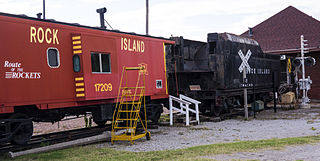
The Rock Island Depot is a one-story brick structure in El Reno, Oklahoma. Built in 1907 on the railroad tracks that ran along the western boundary of the Unassigned Lands that led to El Reno's settlement in 1889, it served as a passenger and freight terminal for the junction of the east–west and north–south lines of the Rock Island Railroad.
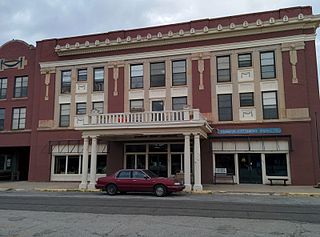
The Southern Hotel is a three-story Classical Revival structure located in El Reno, Oklahoma. Listed on the National Register of Historic Places in 1978, the building was constructed in 1909 as a hotel for passengers traveling the Rock Island Railroad as well as travelers along the Oklahoma Railway Company's interurban line to Oklahoma City. When it was built, the Southern Hotel was one of the most opulent and extravagant hotels in Oklahoma.

The El Reno Heritage Express is a heritage streetcar line in El Reno, Oklahoma. It opened in 2001 as the only operating streetcar in the state. A single J.G. Brill Strafford Car runs a 1.5-mile (2.4 km) excursion service from the Canadian County Historical Museum in the former El Reno Chicago, Rock Island and Pacific Railroad Depot to a balloon loop downtown via a single-track line embedded in the road surface of Watts Street and Bickford Avenue.
The El Reno Railroaders was the final moniker of the minor league baseball teams based in El Reno, Oklahoma between 1904 and 1923. The El Reno minor league teams played as members of the Southwestern League in 1904, Oklahoma State League in 1908, Western Association in 1909 to 1910 and Oklahoma State League 1922 to 1923. El Reno teams hosted minor league home games at Adams Park.















